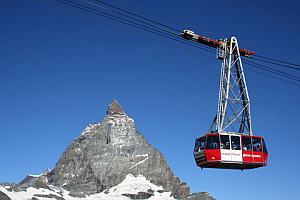
…a small alpine village surrounded by four thousand meters high peaks came to be. Zermatt is a place abundant with wooden cottages on which thousands of flowers decorate every balcony, a place where serene murmuring of a river and cow bells substitute traffic noise. There is no waste to be seen here, all meadows and lawns are trimmed to perfection with marmots carelessly running around taking little interest in human visitors. Villagers are always pleasant to welcoming the guests in as much as four different languages. It might seem that this place is an imaginary one from some Alp fairytale; however, Zermatt, a paradise hidden deep in the heart of the Swiss Alps is real enough.
There are not many ski resorts that leave an impression as Zermatt, even at the first glance. If you are a nature enthusiast, skier, alpinist, hiker or you just take pleasure in walks, you will definitely benefit here. You won’t be the wonder of many here if you come to your afternoon coffee break wearing a rucksack packed with spring safety hooks and ropes or in the evening when you go to dinner in a fancy restaurant wearing your hiking boots. This is perfectly normal here as Zermatt is surrounded by as much as 38 (!) mountain peaks all of them higher than 4000 meters. Consequently, this is a starting point for numerous alpine expeditions and hikers taking pleasure in untouched nature. However, the reason of our visiting Zermatt was to find out what its ski trails, enjoyed throughout the whole year, have to offer.
 If you are coming to Zermatt via Milan, follow the road northwards. The highway ends when approaching Swiss boarder and the Simplon Pass follows (it can be avoided taking the car train). Simplon PassSaastal Valley and the other right to Mattertal Valley, with Zermatt at the end of that road. Road toll costs about EUR25 - 30 (depending on the way you are travelling from) and Swiss yearly road vignette is not required. descends to Swiss town of Brig from where you need to follow the road signs leading to Visp. From Visp the road branches off, one branch leading left to
If you are coming to Zermatt via Milan, follow the road northwards. The highway ends when approaching Swiss boarder and the Simplon Pass follows (it can be avoided taking the car train). Simplon PassSaastal Valley and the other right to Mattertal Valley, with Zermatt at the end of that road. Road toll costs about EUR25 - 30 (depending on the way you are travelling from) and Swiss yearly road vignette is not required. descends to Swiss town of Brig from where you need to follow the road signs leading to Visp. From Visp the road branches off, one branch leading left to
The end of your car journey is at Täsch where you should park your vehicle on one of the numerous public parking lots, as only local taxi and those with special permission traffic are allowed from there. Parking places are abundant with prices from CHF 4 - 6 per day. Each parking lot has taxi-vans which can transport you to Zermatt (they cost about 10 CHF per person) and there is also the train (the ticket costs CHF 7. 80). However all transportation means are only allowed to the Zermatt entrance where the journey ends for all fuel vehicles. Zermatt is entirely a “car -free” area with only electrical vehicles allowed. If you booked accommodation in advance it is very likely that your hotel or apartment house offers a free transportation service for guests thus (if you inform your taxi driver in Täsch about it), a small electric “box” will be waiting for you at the entrance.
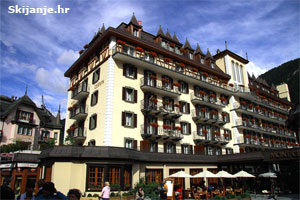 All boarding capacities, hotel or apartment type, are of first-rate quality regardless the categorization with corresponding prices. Overnight stay, breakfast included, costs about CHF100 -150 per person, depending on the view and the season. The prices of apartment boarding are a bit lower, approximately CHF 50 per person.
All boarding capacities, hotel or apartment type, are of first-rate quality regardless the categorization with corresponding prices. Overnight stay, breakfast included, costs about CHF100 -150 per person, depending on the view and the season. The prices of apartment boarding are a bit lower, approximately CHF 50 per person.
Zermatt is a small village, thus in order for a walk from there you will need not more than 45 minutes. However, if you head to the gondola lift in full equipment you can take the electrical bus for free included in the price of the ski pass. Bus stops are plentiful with lines, with the busses coming and going precisely on a minute. During the summer skiing season, starting station is the gondola lift at the town’s outskirts leading to Furi. In winter season, you can choose between taking an underground train leading to Sunnegga and Rothorn Paradise or the one to Gornergrat. In summer there are 20 kilometres of trail in total. However, in winter this resort is connected with Italy’s Cervinia, the total trails' length then amounting to immense 313 kilometres. Snow is abundant here; the resort itself is at an extremely high altitude level. Likewise, ski lift operating altitudes speak for themselves: 3103 m3405 m Stockhorn, 3480 m Plateau Rosa, and the ski lift transporting skiers even up to 3899 m of altitude at the very Matterhorn Glacier Paradise. This is also a summer ski centre, reachable by three gondola lifts with the last one, the highest Europe’s gondola, reaching up to Klein Matterhorn. Rothorn Paradise,
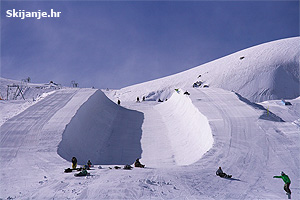 In summer, Zermatt is a snow and ice realm with sometimes almost real winter skiing conditions. It frequently snows in August with temperatures dropping down to -10 °C thus coming to the glacier you get the feeling of skiing in the middle of winter months. For that reason, many national teams set up their summer camps here. Due to large number of World Cup competitors training here, most glacier trails are, unfortunately, unavailable. However, regarding the immense size of this glacier resort there is plenty of trails for everybody. Beside first rate groomed trails, you can enjoy free ride in pristine snow (yes, even in summer!). However, one has to be careful due to great amounts of cracks and possible avalanches. If you are interested, Zermatt has even a Gravity snowpark, which is meticulously groomed, with its very own ski lift.
In summer, Zermatt is a snow and ice realm with sometimes almost real winter skiing conditions. It frequently snows in August with temperatures dropping down to -10 °C thus coming to the glacier you get the feeling of skiing in the middle of winter months. For that reason, many national teams set up their summer camps here. Due to large number of World Cup competitors training here, most glacier trails are, unfortunately, unavailable. However, regarding the immense size of this glacier resort there is plenty of trails for everybody. Beside first rate groomed trails, you can enjoy free ride in pristine snow (yes, even in summer!). However, one has to be careful due to great amounts of cracks and possible avalanches. If you are interested, Zermatt has even a Gravity snowpark, which is meticulously groomed, with its very own ski lift.
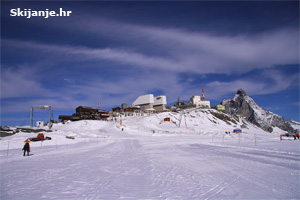 At the glacier, beside 5 anchor lifts operating in summer, you can take a break in a mountain restaurant at the Plateau Rosa. If you get the bill in Euros do not be surprised; the restaurant is actually situated in Italy. After a day’s skiing, it is worth your while to visit the ice cave situated below the Klein Matterhorn, its entrance free of charge. Be sure to ascend up to the belvedere at the top of Klein Matterhorn, with the magnificent view on the surrounding mountain peaks and the glorious rock of the great Matterhorn. In the near future, the construction of a glass pyramid is expected to be finished here. It will have restaurants, a museum and a belvedere which will top the existing one and cross the altitude line of 4000 m! All this will literally leave you breathless because at 3900 m the air is already considerably thin and certain time is needed for acclimatization.
At the glacier, beside 5 anchor lifts operating in summer, you can take a break in a mountain restaurant at the Plateau Rosa. If you get the bill in Euros do not be surprised; the restaurant is actually situated in Italy. After a day’s skiing, it is worth your while to visit the ice cave situated below the Klein Matterhorn, its entrance free of charge. Be sure to ascend up to the belvedere at the top of Klein Matterhorn, with the magnificent view on the surrounding mountain peaks and the glorious rock of the great Matterhorn. In the near future, the construction of a glass pyramid is expected to be finished here. It will have restaurants, a museum and a belvedere which will top the existing one and cross the altitude line of 4000 m! All this will literally leave you breathless because at 3900 m the air is already considerably thin and certain time is needed for acclimatization.
 In winter, Zermatt offers an underground train, 13 gondola lifts, 9 chair lifts, 10 lifts and one train, with Cervinia lifts in addition. Beside blue, red and black trails, there are also yellow trails in Switzerland. Free-ride trails are marked yellow on the trail maps with as much as 38 km in total here! You should also keep in mind that Zermatt is one of the odd European resorts where you can legally ski with a helicopter. If your pockets are deep enough, you can heliski from Monta Rosa, where the highest peak of Switzerland Dufourspitze (4634 m) is situated. Longest Switzerland’s trail of 22 km in total is also to be found here. There is a small pocket map with instructions how to compose a ski-safari in two variants; with 10000 or 12500 meters of altitude height to be skied.
In winter, Zermatt offers an underground train, 13 gondola lifts, 9 chair lifts, 10 lifts and one train, with Cervinia lifts in addition. Beside blue, red and black trails, there are also yellow trails in Switzerland. Free-ride trails are marked yellow on the trail maps with as much as 38 km in total here! You should also keep in mind that Zermatt is one of the odd European resorts where you can legally ski with a helicopter. If your pockets are deep enough, you can heliski from Monta Rosa, where the highest peak of Switzerland Dufourspitze (4634 m) is situated. Longest Switzerland’s trail of 22 km in total is also to be found here. There is a small pocket map with instructions how to compose a ski-safari in two variants; with 10000 or 12500 meters of altitude height to be skied.
Six day ski lift pass costs CHF 346 in winter season. If you want to ski in the Cervinia region as well, the price goes up to CHF 390. One day summer ski lift pass costs CHF 64 and two day ski lift pass is CHF 114. Children up to 9 years of age ski free of charge.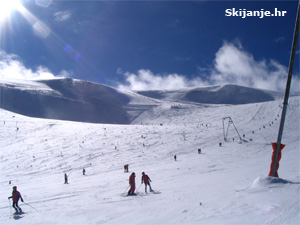 After skiing and descending to the town, the fun doesn’t stop. Zermatt is brimming with restaurants, pubs and night clubs, particularly with shops and souvenir shops. Prices are expectantly high, the same as in all parts of Switzerland. Fast food items - kebabs, hamburgers and other similar items cost CHF9, more wholesome meals like a pizza or pasta dish CHF20 with Wiener snitzel and other meat specialities from CHF30 up. Beer is about CHF6, Coca Cola about 4CHF. Interestingly enough, local supermarket prices (there is a big Coop supermarket opposite the train station) are very agreeable. If you happen to be in the area, be sure to try rosti and fondue, most famous Switzerland’s specialities. Rosti is a kind of a potato dish, whereas fondue can be served in many variations, the most famos cheese fondue. Both dishes cost about CHF20 - 25.
After skiing and descending to the town, the fun doesn’t stop. Zermatt is brimming with restaurants, pubs and night clubs, particularly with shops and souvenir shops. Prices are expectantly high, the same as in all parts of Switzerland. Fast food items - kebabs, hamburgers and other similar items cost CHF9, more wholesome meals like a pizza or pasta dish CHF20 with Wiener snitzel and other meat specialities from CHF30 up. Beer is about CHF6, Coca Cola about 4CHF. Interestingly enough, local supermarket prices (there is a big Coop supermarket opposite the train station) are very agreeable. If you happen to be in the area, be sure to try rosti and fondue, most famous Switzerland’s specialities. Rosti is a kind of a potato dish, whereas fondue can be served in many variations, the most famos cheese fondue. Both dishes cost about CHF20 - 25.
Language barrier is none existant here. Although Zermatt is a part of the German-speaking region, one and all are fluent in Italian, English and French, as well.
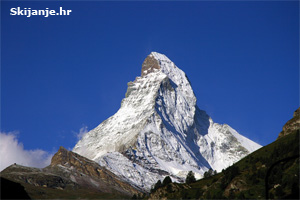 To speak of Zermatt and not to mention MatterhornMatterhorn is the most famous Switzerland’s most prominent mountain peak, striking and magnificent rock with 4478 m of height hanging precipitously over Mattertal Valley. Matterhorn features absolutely everything in this region starting from the name of the resort itself (Matterhorn Ski Paradise), to being the inevitable motif of postcards and souvenirs. Did you know that the famous Toblerone candy bar owes its recognizable triangular shape to Matterhorn? Next time you get a hold of Toblerone, try to find what is there on the cover hiding in the Matterhorn silhouette. would be almost impossible.
To speak of Zermatt and not to mention MatterhornMatterhorn is the most famous Switzerland’s most prominent mountain peak, striking and magnificent rock with 4478 m of height hanging precipitously over Mattertal Valley. Matterhorn features absolutely everything in this region starting from the name of the resort itself (Matterhorn Ski Paradise), to being the inevitable motif of postcards and souvenirs. Did you know that the famous Toblerone candy bar owes its recognizable triangular shape to Matterhorn? Next time you get a hold of Toblerone, try to find what is there on the cover hiding in the Matterhorn silhouette. would be almost impossible.
Zermatt is indeed a place out of a fairy tale, in winter or in summer. When leaving Zermatt, the only thing you know for sure is that you will certainly be coming back!
www.ski-mag.com
No comments:
Post a Comment